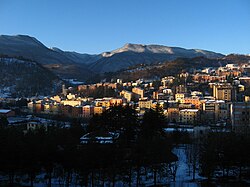| Tuscan-Marche Romagna Apennines | |
 | |
| State | Italy |
|---|---|
| Region | Emilia Romagna |
Tuscan-Marche Romagna Apennines is a region ofItaly.
To know
Geographical notes
It includes the Apennines of the Romagna bordering the Tuscany and the Marche; the territory of the Republic of San Marino, between Valmarecchia, Romagna Riviera is Marche, which is part of it geographically and culturally.
Background
The Apennine reliefs of Romagna contrast with the Tuscan and Marche mountains. Until contemporary times the mountains south of Forlì constituted the Tuscan Romagna, that is that part of the Apennine territory that reached up to 10 kilometers from Forlì and which had been the domain of the Medici and the Grand Duchy of Tuscany, remaining Tuscan territory even after the Unification until 1923. Land of the Sun it was a city built from scratch and fortified by the Medici, who made it the capital of Tuscan Romagna. There Valmarecchia instead it has often changed its territorial belonging: it was from the Marche, Romagna, Urbino and Rimini regions; finally divided between Romagna is Marche. Following a popular referendum in 2009, almost all of its territory was reunited within the Romagna borders; are its important centers Novafeltria, Pennabilli, Carpegna, San LeoVerucchio, Santarcangelo of Romagna.
Territories and tourist destinations

Urban centers
Below is a list of the main urban centers and spa towns, some very well known, others less known, which are Apennine centers located in theRomagna Apennines.
- Pennabilli - In an elevated position it preserves the old medieval core. It was the cradle of the Malatesta family, who later became the lady of Rimini. It is the religious center of the area, as it is the seat of the Diocese of San Marino he was born in Montefeltro.
- San Leo - The Rocca di San Leo is the fifteenth-century work of Francesco di Giorgio Martini, which stands on the top of the cliff on which the inhabited area develops; it seems inaccessible, and emanates an astonishing sense of power and strength. The city also offers a prestigious urban center, with the medieval buildings of the Cathedral and the Pieve.
- Santarcangelo of Romagna - It has a medieval core and retains a quadrilateral fortress with corner towers built by the Malaspina in the 13th-14th century. It has an eighteenth-century Collegiate Church.
- Sarsina - Ancient Umbrian and then Roman city, it preserves traces of the primitive center; the Archaeological Museum of Sarsinate collects its Roman finds, among which there are some very remarkable pyramidal cusp mausoleums dating back to the 1st century BC. found in the Roman necropolis. Its Cathedral, although remodeled, shows much of its original Romanesque structure.
- Verucchio - The Malatesta Fortress high above the town dominates the village, in which the Collegiate Church is worth a visit, which houses numerous works of art.
Thermal centers
- Bath of Romagna - Climatic stay and spa treatments are the strengths of this Apennine center, which offers the visitor a beautiful fifteenth-century Basilica of elegant Florentine forms and important works by Neri di Bicci and the Tuscan school. It also has three thermal springs equipped with accommodation facilities; its warm waters (gushing out at 45 and 39 degrees centigrade) were known and used since Roman times.
- Bertinoro - The Terme della Fratta di Bertinoro were already used by the Romans, as evidenced by archaeological discoveries. Their reuse in the modern age is quite recent. The springs are seven and are located within a park of thirteen hectares.
- Brisighella - Her Thermal baths arise in a park in the center of the town.
- Castrocaro Terme - It is certainly the best known spa in Romagna. Its use for therapeutic purposes begins in 1838.
- Porretta Terme - Known since ancient times, the thermal waters of Porretta boast an almost continuous use, with few periods of abandonment.
- Riolo Terme - The opening of its thermal baths dates back to 1877, seven years after the construction of the thermal building began.
How to get
How to get around
What see
What to do
At the table
Safety
Other projects
 Wikipedia contains an entry concerning Tuscan-Marche Romagna Apennines
Wikipedia contains an entry concerning Tuscan-Marche Romagna Apennines Commons contains images or other files on Tuscan-Marche Romagna Apennines
Commons contains images or other files on Tuscan-Marche Romagna Apennines
